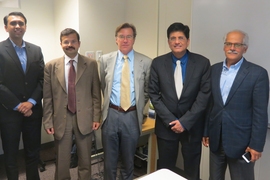In India, industrial development and rapid urbanization have far outpaced efforts to protect the environment, resulting in levels of air and water pollution that pose major threats to human health. Within MIT's School of Humanities, Arts, and Social Sciences, two doctoral students in economics are working to address this challenge by generating incentives for polluters to change their ways.
Third-year PhD student Ariel Zucker is developing an environmental rating program for industrial smokestack emissions, and fourth-year PhD student Nick Hagerty is designing a cap and trade program intended to reduce pollution from industrial wastewater. Both projects were developed through MIT’s Tata Center for Technology and Design, whose mission is to address the challenges of resource-constrained communities.
Environmental ratings
"Even if you have great technology, you need some incentive for people to reduce pollution," Zucker says. India has high environmental standards, but its regulations are not well enforced. Since many companies simply don't bother to adopt pollution control measures, she says, "You need some way to make the benefit of reducing pollution felt by the ones who are paying the cost of reducing pollution."
Zucker is working with a team of professors from Harvard University, Yale University, and the University of Chicago to tackle this issue by giving companies a public reputation for environmental performance — for good or ill. The team is collecting data on stack emissions from about 100 industrial plants in the state of Maharashtra and ranking each plant based on the amount of particulate matter it is releasing into the atmosphere. They plan to assign each plant a star rating and publish the ratings online.
"Right now for whatever reasons the marginal cost of abating pollution is higher than the marginal benefit, so what we’re doing is attacking this," she says. "It’s feasible and pretty low-cost for many of these industries to come closer to compliance. If it’s not worth their reputation to do it, they won’t do it. If it is they will."
Zucker's team is now meeting with industry leaders to get their feedback on the project. The ratings system is expected to go into operation in the spring, after which the group will continually monitor smokestack emissions to evaluate the project's impact.
"I think this project will give industry groups some incentives to start being better citizens," Zucker says. "We see a lot of room for small, low-cost improvements that can have a big impact on pollution."
Cap and trade
Hagerty's project — developed with the same team of professors — provides a financial incentive to polluters to clean up their act by enabling companies to work together to meet pollution reduction goals. The strategy challenges the assumption that pollution is the natural cost of economic development and that reducing pollution necessarily erodes growth.
"What if there were a way to transcend this tradeoff — to reduce pollution without killing off industry? We’ve seen in other parts of the world that there is a tool that can achieve that: It’s emissions trading, or cap and trade," Hagerty says.
Working with an environmental regulator and a local industrial association, Hagerty and the team plan to monitor the industrial wastewater released by about 110 factories that share a treatment facility in the state of Gujarat. They will then provide plants with pollution permits and enable the companies to trade these among themselves.
This cap and trade strategy makes it possible for a facility that faces high cleanup costs to pay another facility — for example, one with a more modern, cleaner operation — to take on an additional burden of emissions reductions so that the group as a whole can meet more stringent goals.
"In this scheme we don’t as much care who is producing pollution; we just want overall pollution to fall," Hagerty says. "This provides an incentive for firms collectively to figure out where the least expensive pollution reductions are going to come from."
Sociotechnical solutions
Both of these MIT Economics/Tata Center projects point to the value of incorporating thinking from the social sciences into environmental remediation projects, the students say.
"Incentives matter for how people behave," Hagerty explains. "What economics can show is why people and firms end up doing things like polluting even when they know that they’re destructive — and also how we can restructure incentives in a way that not only altruistic, but even self-interested, groups will end up doing the right thing."
The pilot wastewater cap and trade system in Gujarat is expected to begin operation in April. Once the system is up and running, researchers will conduct an impact evaluation to see how well the project worked to reduce industrial water pollution. If the pilot is successful, the system could be expanded to other industrial operations throughout the state and eventually throughout India, Hagerty says.
More examples of sociotechnical problem-solving can be found in The Human Factor series, which examines the economic, political, cultural dimensions of global challenges.











